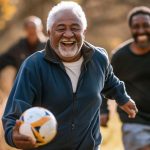I love hearing about older people who have defied the myth of old age.
One of my favorites is Ernestine Shepherd. When she was in her late 50’s, she looked and acted like we seem to think people approaching their 60’s should. She was overweight, had no interest in exercise, and had never worked out a day in her life.
But guess what happened?
After the devastating death of her sister, she decided to get in shape. Ernestine slowly began exercise training and started eating a healthier diet. She never stopped.
Now, at the age of 87, this beautiful, youthful looking woman is the world’s oldest living female competitive bodybuilder. Not only that, but she continues teaches classes to seniors at the local gym!
I ran across another of these elderly gems a couple of months ago.
A study published in December 2023 revolved around a 93-year-old man by the name of Richard Morgan. He was 92 at the time of the study and, as a four-time master world champion indoor male rower, the analysis zeroed in on his health.
It turns out the man has the heart and body of a healthy 30-or-40-year-old. This includes heart health, lung function, muscle mass and overall fitness level.
The most incredible thing about Mr. Morgan’s journey is that he wasn’t very active until he started working out in his 70s!
Forever Young
These are the kinds of people who prove that a healthy, active lifestyle in later life isn’t out of reach. It’s possible.
Ernestine began her metamorphosis on the approach to 60, just about the age where a good number of people give up on youth. Richard started his at an age where many others have already decided to simply succumb to old age.
Still, they are living proof that when positive changes are made, amazing things can happen. And the fact is, anything you do is better than nothing.
For example, imagine you are 70 years old. You’re obese. Out of shape. Then someone offers to support you through a 10-week vigorous-intensity interval training exercise program, three times a week.
Well, that’s exactly happened to a small group of lucky men and women living in Sweden.
These folks started out exercising for 18 minutes a day, three times a week, with 40-second exercise intervals and 20-second rest intervals. Over the weeks, they worked their way up to 36-minute sessions of greater duration and intensity.
Another group of 70-year-old-obese individuals didn’t participate in the program.
After the end of ten weeks, guess what the results were?
The people who exercised saw a nearly triple decrease in total fat mass compared with the folks who didn’t. They had better BMIs and also increased their lean fat mass.
Plus, the program was extremely easy to stick with. Nearly 90% of the exercisers completed the entire 10 weeks of training.
That’s the glory of these high-intensity-interval workouts. You don’t have to be fit to get started. All you need to be able to do is move your body.
And if a group of obese, out of shape septuagenarians can successfully do it, you can do it too!
Life is Movement, and Movement is Life
Here’s a truth: If you don’t keep moving as you age, they’ll dig you a hole and put you in it.
Movement keeps your blood flowing. Movement strengthens your heart and other muscles, stimulates brain connectivity and supports healthy bones. The more active and engaged you remain as you age, the better chances you have of maintaining mobility and cognitive function.
Physical activity…
- Helps your body make more mitochondria, the energy factories that keep your body powered up and youthful.
- Has a positive influence on the expression of genes that protect against metabolic disorders, heart disease, cancer and neurodegenerative diseases like Alzheimer’s and Parkinson’s.
- Is, by far, the best way to boost your brain derived neurotrophic factor (BDNF) levels. People with higher BDNF levels are less likely to develop dementia and Alzheimer’s.
So to help maintain (or regain!) your youth, start moving your body more frequently. At the very minimum, I recommend walking for 30 minutes each morning and evening with several bursts of added intensity.
As you build strength and endurance you will be able to add other, more strenuous physical activity such as sprinting, hiking, bicycling, rowing and other activities upon the approval of your health professional.
SOURCES:
Daly LS, Van Hooren B, Jakeman P. Physiological characteristics of a 92-yr-old four-time world champion indoor rower. J Appl Physiol (1985). 2023 Dec 1;135(6):1415-1420.
Ballin M, Lundberg E, Sörlén N, Nordström P, Hult A, Nordström A. Effects of Interval Training on Visceral Adipose Tissue in Centrally Obese 70-Year-Old Individuals: A Randomized Controlled Trial. J Am Geriatr Soc. 2019 Aug;67(8):1625-1631.
Gonzalez-Freire M, de Cabo R, Bernier M, Sollott SJ, Fabbri E, Navas P, Ferrucci L. Reconsidering the Role of Mitochondria in Aging. J Gerontol A Biol Sci Med Sci. 2015 Nov;70(11):1334-42.
Grazioli E, Dimauro I, Mercatelli N, Wang G, Pitsiladis Y, Di Luigi L, Caporossi D. Physical activity in the prevention of human diseases: role of epigenetic modifications. BMC Genomics. 2017 Nov 14;18(Suppl 8):802.
Mok A, Khaw KT, Luben R, Wareham N, Brage S. Physical activity trajectories and mortality: population based cohort study. BMJ. 2019;365:l2323.




